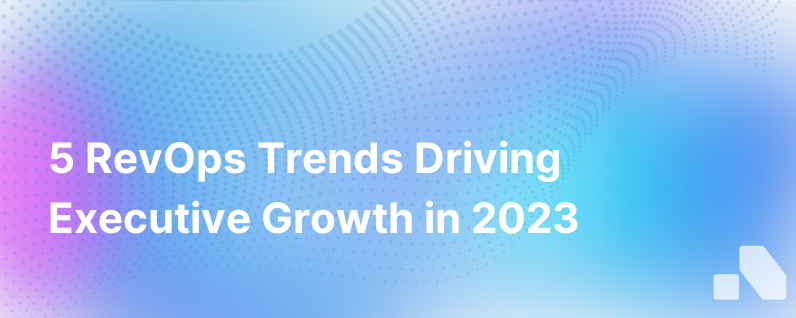
In the dynamic world of sales, marketing, and customer service, the emergence of Revenue Operations (RevOps) has revolutionized how organizations align these functions to drive growth effectively. As we delve into the latest developments in RevOps, it's vital to stay abreast of transformative trends that can bolster operational efficiency, amplify sales productivity, and ultimately, accelerate revenue growth.
As we navigate 2023, here are five RevOps trends that are reshaping the landscape for growth-minded organizations:
1. Artificial Intelligence and Machine Learning Integration
The integration of Artificial Intelligence (AI) and Machine Learning (ML) is a force multiplier in RevOps. AI/ML algorithms are not only enhancing predictive analytics -- providing deeper insights into sales forecasting and customer behavior -- but they’re also automating repetitive tasks, thereby freeing up time for sales and marketing teams to focus on strategic tasks and relationship building.
Organizations are increasingly utilizing these technologies for lead scoring, sales intelligence, and personalized customer communications. For instance, AI can analyze vast datasets to identify patterns that human analysts might overlook. This allows for a more nuanced approach to customer segmentation and targeting, ensuring efforts are concentrated where they will have the most significant impact.
2. Data-Driven Decision-Making
Data is the fuel that powers the RevOps engine. As the volume of data collected by businesses grows exponentially, so too does the need for comprehensive tools to manage and make sense of it. Companies are adopting advanced analytics platforms capable of handling large datasets to inform decisions across sales, marketing, and customer service functions.
With clean, high-quality data at their disposal, RevOps teams can uncover actionable insights that drive strategic initiatives. This includes refining buyer personas, customizing sales approaches, and optimizing the customer journey. By leveraging data to guide decisions, organizations increase their ability to adapt and evolve with changing market conditions and customer expectations.
3. Emphasis on Customer Success as a Revenue Driver
The scope of RevOps extends beyond the initial sale, with a growing emphasis on customer success as a pivotal revenue driver. In the era of subscription-based models and SaaS offerings, customer retention and expansion revenue are critical metrics. As such, RevOps strategies are increasingly incorporating customer success plans that nurture long-term value for both the organization and the customer.
Investments in customer success platforms that facilitate onboarding, user education, and support are on the rise. By doing so, businesses aim to increase customer satisfaction and loyalty, driving upsells, cross-sells, and advocacy. Capturing and leveraging customer feedback has become an essential element of the RevOps toolkit, informing the optimization of products and services to better meet customer needs.
4. Enhanced Cross-Functional Collaboration
Cross-functional collaboration is the cornerstone of successful RevOps implementation. The trend toward breaking down silos and fostering transparency across sales, marketing, and customer service is gaining momentum. Enhanced collaboration ensures that all departments work toward a unified set of goals.
Sales enablement platforms and collaborative software are facilitating this alignment, ensuring real-time communication and shared access to essential information. As the RevOps framework continues to mature, we're witnessing the emergence of platforms designed to unify these functional areas into a cohesive whole, where bypassing inefficiencies and misalignment leads to substantial growth.
5. Focus on Customer Lifecycle Management
Finally, there’s a growing recognition of the importance of managing the entire customer lifecycle, from initial engagement through to advocacy. RevOps teams are developing comprehensive strategies to guide customers through each stage of their journey, with tailored content, touchpoints, and offers.
By mapping out the customer lifecycle and identifying key interactions, organizations can ensure that each function plays its part in delivering a seamless customer experience. This holistic management approach not only increases customer satisfaction and retention rates but also aligns closely with the overarching goal of RevOps to drive growth through customer-centric initiatives.
RevOps and the Quest for Strategic Growth
These RevOps trends reflect a strategic shift in how growth is achieved in modern businesses. Rather than focusing solely on the top line, companies are investing in the systems, processes, and technologies that support revenue generation across all customer touchpoints.
By integrating AI and ML, harnessing the power of data-driven decision-making, prioritizing customer success, enhancing cross-functional collaboration, and focusing on the entire customer lifecycle, organizations set the stage for sustainable, long-term growth.
One such platform that embodies these trends is Aomni. Its AI-driven tool seamlessly integrates real-time account research with competitive insight and streamlined content personalization. The platform equips teams to act swiftly and strategically, ultimately empowering them to capture market opportunities with zero manual effort.
As we look to the future, RevOps stands poised to become an even more fundamental aspect of business strategy. Those who stay ahead of these trends and continuously evolve their RevOps processes will be well-positioned to outpace the competition and capitalize on growth opportunities in an increasingly complex commercial landscape.